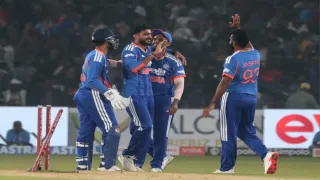How did cricket start in India?

The earliest mention of cricket in India dates back to the beginning of the third decade of the 18th century. According to the official website of the Board of Control for Cricket in India i.e. BCCI, at that time a British ship had anchored in Kutch in present-day Gujarat. References to the sailors of that time show that they, along with other activities, also played cricket to pass the time.
After this, cricket game gradually started in India. Calcutta Cricket Club was started in the year 1792. This club is the oldest cricket club in the world after MCC Club of London. At that time, the Parsi community was the first to adopt cricket in India.
In the year 1848, the Parsi community started the Oriental Cricket Club. After this the Parsi community also opened many other cricket clubs. At that time, the Parsi community had no shortage of resources, which is why they allowed their team to be sent to Britain.
In the year 1889-90, an England team that toured India under the captaincy of GF Vernon was defeated by a team from the Parsi community by four wickets.

This was a huge victory for any Indian cricket team. Boria Majumdar, senior sports journalist, historian and co-author of Sachin Tendulkar's autobiography, Playing It My Way, has written about The Bombay Pentangular. It is published by 'The International Journal of the History of Sports'.
Boria Majumdar writes in his article, The Parsis had formed many cricket clubs. The Hindu community then competed with the Parsi community in the business world of Bombay. This was also one of the reasons that after the Parsi community, Hindus also started playing cricket.
"The first Hindu cricket club was established in 1866 with the name 'Bombay Union'. While the clubs of the Parsi community were formed in the name of regions, on the other hand, the clubs of Hindus were formed in the name of caste and religion."
Before the opening of 'The Bombay Pentangular' in the 1890s, matches were played at annual events between European clubs and the Parsi communities in India. In 1907, these matches became triangular and the Hindu community team also joined it. In 1912, a team from the Muslim community also joined and in 1937, a team named 'Rest' was formed, which had players from the Anglo-Indian and Christian communities.
Its name may have been Pentangular Tournament, but only four teams took part in it. Kaushik Bandhopadhyay has written a book named 'Mahatma on Pitch', in which he has written in detail about 'The Bombay Pentangular' tournament.
Kaushik writes that till 1912, there was no major communal incident of any kind due to this tournament. Such tournaments were being organized in other parts of the country like Sindh, Lahore, Delhi and Central Province.
Kaushik writes that at that time the popularity of cricket was increasing rapidly in India due to the competitive spirit of different communities. Kaushik says that it was seen among the people who came to watch the match that they had come to the field for their respective communities.
The spirit of sportsmanship in this tournament was seen intact till the beginning of the 1930s. Kaushik writes, When the Muslim team won the tournament in 1924, Hindus joined in celebrating their victory. Even Mohammed Ali Jinnah praised this good sportsmanship.
There was communal competition between communities
Quoting the famous historian Gyanendra Pandey, Kaushik has written that before the 1920s, India was seen as a collection of different communities, in whose framework tournaments like 'The Bombay Pentangular' fit perfectly.

This attitude towards India began to change in the 1920s.
Kaushik writes, "The tournament sparked debate about the need for religion-based team competitions in India emerging as a nation. There were two factions in the debate, one of which said that the competition would bring communities together through cricket. While the other group said that such tournaments are creating a spirit of bad competition, alienating communities from each other.
According to Kaushik, after the establishment of BCCI in 1928, voices were raised against these competitions, but many people were also in favor of such tournaments.
He explains, There were Hindu-Muslim riots before the Bombay Quadrangular of 1936. At that time 'The Bombay Chronicle' had said that the time had come that this competition should be stopped, otherwise it would only increase bitterness between the communities. 1937 In 2007, when 'remaining sides' were being included in the tournament, big personalities like JC Mitra and JM Ganguly suggested that the tournament should be discontinued in the interest of the country.
Also Read: Why is Ishan Kishan struggling with his career?













Give Your Feedback